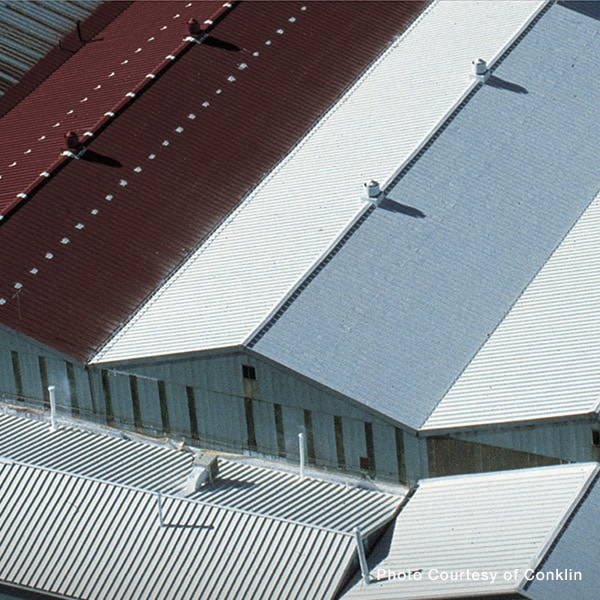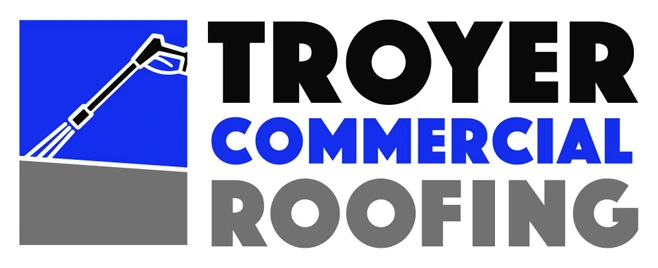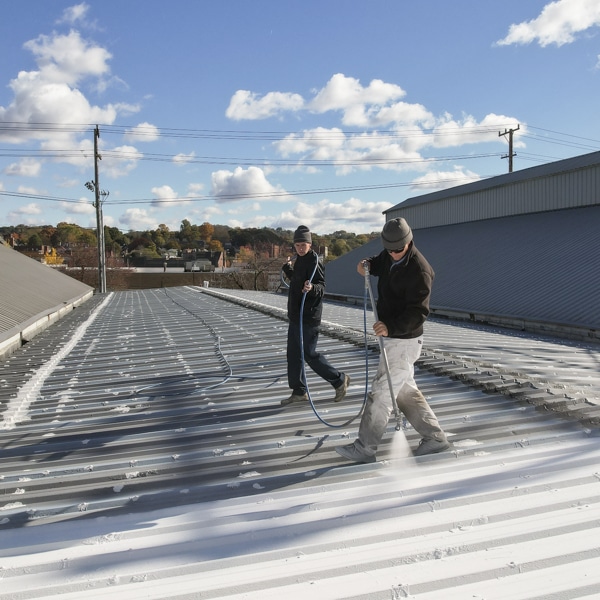Industrial Roof Repair
Any facility or operations manager in charge of an industrial facility understands how essential maintenance and industrial roof repair is to maintaining smooth operations. We work with various different industries including aerospace, marine, waste management, construction, manufacturing and storage warehouses to name a few. Something that may seem minor, like a small roof leak or weathered flashing, can be costly when the water damage trickles down the structure. This damages property, equipment, and goods. Depending on its severity, it can lead to production delays and impact working conditions. This further escalates costs that can have a negative impact on your operation’s bottom line. This is especially true if it requires roof replacement.

Troyer Commercial Roofing’s trained professionals specialize in industrial roof repair in Sarasota and the rest of Southwest Florida. As an authorized Conklin Roofing Systems contractor, we provide cost-effective, durable, and leak-free industrial roof repair and restoration. This will significantly extend the lifespan of existing and aged metal, EPDM, Thermoplastic Polyolefin (TPO), PVC, Built-up Roofing (BUR), modified bitumen, and other industrial roof types without the time-consuming expense of a traditional industrial roof repair or replacement.
Industrial Roof Repair Eliminates Roof Replacements
For more than 40 years, industrial facilities have been protecting their roofing investment with the Conklin® Roofing System. Conklin’s white reflective acrylic elastomeric coatings, including its Spray Polyurethane Foam (SPF), fabric reinforced, metal roof restoration, and single-ply membrane systems, immediately stop leaks, repair flashing, and helps to prevents future leaks and weather damage with superior waterproofing protection.
Low Maintenance
In addition, these sustainable and renewable, low-maintenance coatings will preserve your existing industrial roof for decades. With periodic maintenance by recoating, you can virtually eliminate roof replacements. Furthermore, most industrial roof repair jobs are easily performed with caulking and coating.
EnergyStar “Cool Roof” Technology
Its built-in EnergyStar and Cool Roof Rating Council (CRRC) rated white reflective, “cool roof” technology and insulation layer outperform many other reflective materials, substantially reducing your rooftop’s ambient surface temperature by 50°F to 80°F. This means the air inside and around your industrial facility will be more energy-efficient, resulting in less pollution and lower utility costs. It will also help to reduce your industrial facility’s carbon footprint.
Reduces Energy Consumption & Utility Costs
Most industrial roofing materials like asphalt, concrete, and aluminum, can absorb a significant amount of UV radiation. This causes rooftop temperatures to soar in hot and humid weather. As a result, the surface temperature of an asphalt rooftop can be as hot as 180°F in the summer. This is more than twice the average 90°F ambient summertime temperature in Southwest Florida. Since our “cool roof” industrial roof coatings reflect as much as 89% solar radiation, substantially outperforming other roofing materials, it keeps rooftop surfaces up to 80F cooler. A cooler roof also means cooler indoor temperatures, less wear and tear on HVAC equipment, and a more comfortable interior working environment. Of course, this equates to lower energy consumption and utility costs. You may also qualify for tax credits, rebates, and other incentives.
Durability Resists Severe Weather Conditions
Hurricane season in Florida runs from June 1st to November 30th, so summer weather can be unpredictable. Frequent thunderstorms with heavy rainfall, strong gusty winds, and even hail are not uncommon. This can cause ponding or pooling water and damage to the flashing, seams, and the membrane. These are the most common causes of industrial roof leaks. Conklin’s industrial-strength acrylic elastomeric coatings instantly repair flashing and seals, creating a durable, seamless, weatherproof, and UL-listed fire-resistant membrane. This protects the entire roofing system from severe weather conditions, including hail, rain, UV radiation, and wind. As a result, the roof’s surface is not only smooth and durable but walkable too.
 Industrial Roofing Repair in Florida
Industrial Roofing Repair in Florida
Let us show you how Conklin’s EnergyStar industrial roof coatings can repair and restore your industrial roof system without having to go through the capital expense of a time-consuming roof replacement. For a limited time, Troyer Commercial Roofing is providing FREE industrial roofing inspections in Bradenton, Longboat Key, Parrish, Sarasota, and surrounding communities in Florida. Call to schedule an appointment with our experienced industrial roofers today!
10-Ways a Timely Industrial Roof Repair Can Save You Money
1. Preventing Major Damage and Serious Industrial Roof Repair
Addressing minor roofing issues promptly is crucial to preventing them from escalating into major problems. For example, a small leak can lead to significant water damage over time, compromising insulation, walls, and ceilings. This not only requires an extensive and costly industrial roof repair, but may also necessitate a complete roof replacement. By tackling small repairs as they arise, you can save considerable money by avoiding these larger expenses and protecting the integrity of your building.
2. Reducing Energy Costs
A timely industrial roof repair can significantly impact your energy bills. Damaged roofing materials, such as torn membranes or compromised insulation, can allow conditioned air to escape, leading to increased heating and cooling demands. This results in higher utility costs, especially during extreme weather. By addressing leaks and ensuring your roof is properly sealed, you enhance its energy efficiency, which helps maintain a comfortable indoor environment, while reducing your overall energy consumption and lowering monthly bills.
3. Extending Roof Lifespan
Regular maintenance and timely repairs are essential for prolonging the lifespan of your roofing system. Over time, wear and tear can take a toll, but by promptly addressing issues like cracks, leaks, and damaged flashing, you can prevent them from worsening. This proactive approach delays the need for a full roof replacement, which can be a significant financial burden. By investing in timely repairs, you can extend the life of your roof, ultimately saving money in the long run.
4. Minimizing Disruption to Operations
Timely repairs help ensure that your business operations remain uninterrupted. Delays caused by significant roofing damage can result in operational downtime, which often translates to lost revenue and decreased productivity. For instance, if a leak leads to a temporary shutdown of a manufacturing line, the financial implications can be substantial. By addressing roofing issues promptly, you maintain a consistent workflow, minimize disruption, and protect your bottom line from the impacts of operational delays.
5. Maintaining Property Value
A well-maintained roof plays a vital role in preserving the value of your property. Regular maintenance and timely repairs enhance the overall appearance and functionality of your building, making it more attractive to potential buyers or tenants. If you decide to sell or lease the facility, a well-cared-for roof can serve as a strong selling point. This attention to detail not only maintains but can also increase market value, ensuring a better return on your investment.
6. Avoiding Emergency Industrial Roof Repair Costs
Emergency repairs can be significantly more expensive than routine maintenance due to the urgency and specialized labor often required. When roofing issues are neglected, they can quickly escalate into emergencies that demand immediate attention, leading to inflated costs. By being proactive and addressing repairs as they arise, you can budget effectively for maintenance. This approach allows you to avoid the unexpected financial strain of emergency repairs, leading to more controlled and predictable roofing expenses.
7. Insurance Savings
Keeping up with timely repairs can positively influence your insurance premiums. Many insurance companies offer lower rates for properties that are well-maintained, as these are considered lower risk. By investing in routine maintenance and addressing repairs promptly, you can not only safeguard your property but also potentially qualify for discounts on your insurance policy. Over time, these savings can accumulate, contributing to your overall financial health and allowing for reallocation of funds to other critical areas of your business.
8. Enhanced Safety and Compliance
Neglecting timely repairs can lead to safety hazards, which may expose your business to liability issues and potential fines for non-compliance with building regulations. For example, a roof leak can create slippery conditions that pose safety risks to employees and visitors. By addressing roofing issues as they arise, you maintain a safe working environment, reduce the risk of accidents, and ensure compliance with safety regulations. This proactive approach protects both your employees and your bottom line.
9. Improved Operational Efficiency
A well-maintained roof can enhance the efficiency of your building’s systems, including HVAC. Leaks or damage can lead to a malfunctioning HVAC system, which may struggle to maintain comfortable temperatures and, in turn, consume more energy. This not only increases utility costs but also places undue stress on equipment, potentially leading to more frequent repairs or replacements. By investing in timely roofing repairs, you ensure optimal functioning of all building systems, resulting in improved operational efficiency and cost savings.
10. Increased Longevity of Interior Assets
Water damage from leaks can affect not only the roof but also valuable interior assets, including equipment, inventory, and furnishings. Timely repairs safeguard these investments by preventing water intrusion and the subsequent damage it can cause. By addressing roofing issues quickly, you protect your property from deterioration, ensuring that your assets remain in good condition. This approach minimizes the risk of costly replacements and helps preserve the overall investment in your facility, enhancing its long-term viability.
7 Ways Florida’s Weather Impacts Industrial Roofs and Industrial Roof Repair
1. Temperature Fluctuations
Extreme temperature changes significantly impact industrial roofs, causing materials to expand and contract. This constant movement puts stress on the roofing system, which can lead to cracks, seams separating, and ultimately leaks. In regions with colder climates, freeze-thaw cycles exacerbate these issues, accelerating deterioration. The repeated expansion and contraction can weaken the roofing materials, making timely inspections and maintenance crucial to identify potential vulnerabilities and ensure the roof remains functional and watertight.
2. Rain and Water Accumulation
Heavy rainfall can create serious challenges for flat roofs, often leading to pooling or standing water. When water accumulates, it can compromise the integrity of roofing materials, increasing the risk of leaks and structural damage. Poor drainage systems exacerbate this issue, making it essential for facility managers to monitor roof conditions closely. Implementing effective drainage solutions and conducting regular inspections can help mitigate water accumulation risks, ultimately prolonging the roof’s lifespan and protecting the underlying structure.
3. UV Radiation
Prolonged exposure to ultraviolet (UV) rays poses a significant threat to industrial roofing materials, particularly those made from asphalt or rubber. Over time, UV radiation can cause these materials to degrade, leading to brittleness, fading, and a loss of protective qualities. This degradation not only weakens the roof but also increases the risk of leaks. To counteract this, facility managers should consider applying UV-resistant coatings or using materials specifically designed to withstand UV exposure, thus enhancing durability and lifespan.
4. Wind Damage
Strong winds can pose serious risks to industrial roofs, especially those with flat or low-slope designs. High winds can lift roofing materials, leading to potential displacement or damage, and can carry debris that may impact the roof’s surface, causing punctures or other structural issues. It is essential to ensure that roofing systems are properly installed and maintained to withstand high winds. Regular inspections can help identify weaknesses, enabling proactive measures to secure the roofing and prevent damage.
5. Hail and Severe Weather
Hailstorms can cause significant damage to industrial roofing systems, resulting in dents, punctures, or fractures. The severity of damage often depends on the size and intensity of the hail, as well as the materials used in the roof’s construction. To protect against severe weather events, facility managers should invest in durable roofing materials that can withstand hail and storms. Regular inspections and maintenance can also help identify any damage early, allowing for timely repairs to mitigate further issues.
6. Moisture and Humidity
High humidity levels can lead to various issues for industrial roofs, including the deterioration of materials and the growth of mold. Excess moisture can contribute to corrosion in metal components and weaken the roofing structure, making it more vulnerable to leaks. Effective ventilation and moisture management strategies are essential to mitigate these risks. Regular inspections can help identify areas where moisture accumulates, enabling proactive measures to maintain a healthy roofing system and prevent costly repairs.
7. Seasonal Changes
Seasonal weather variations can greatly influence the performance of industrial roofs and affect maintenance schedules. For example, during the rainy season, roofs may require more frequent inspections to address potential leaks or drainage issues. Additionally, harsh winter conditions may necessitate snow removal to prevent excessive weight on the roof. Facility managers should adapt maintenance practices based on seasonal weather patterns to preserve roof integrity, ensuring the roofing system remains functional and capable of withstanding various environmental challenges.

 Industrial Roofing Repair in Florida
Industrial Roofing Repair in Florida